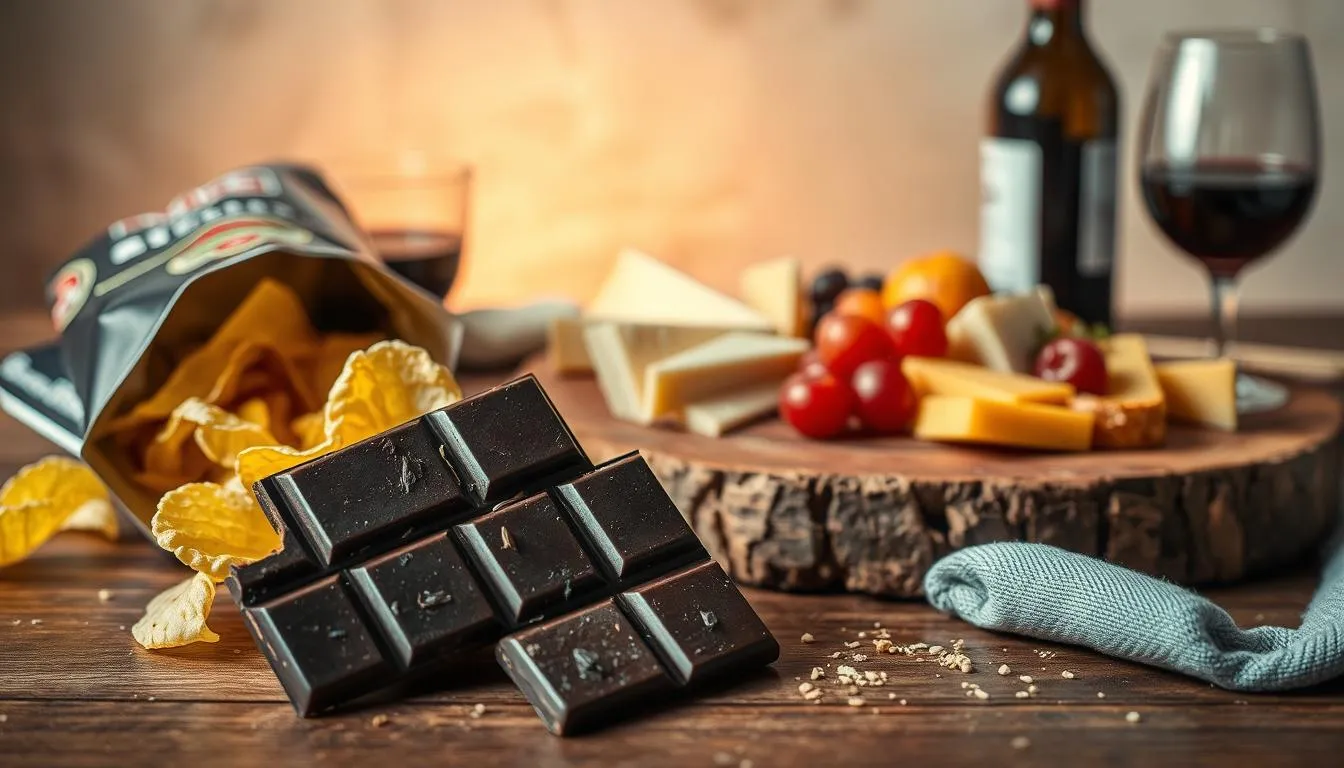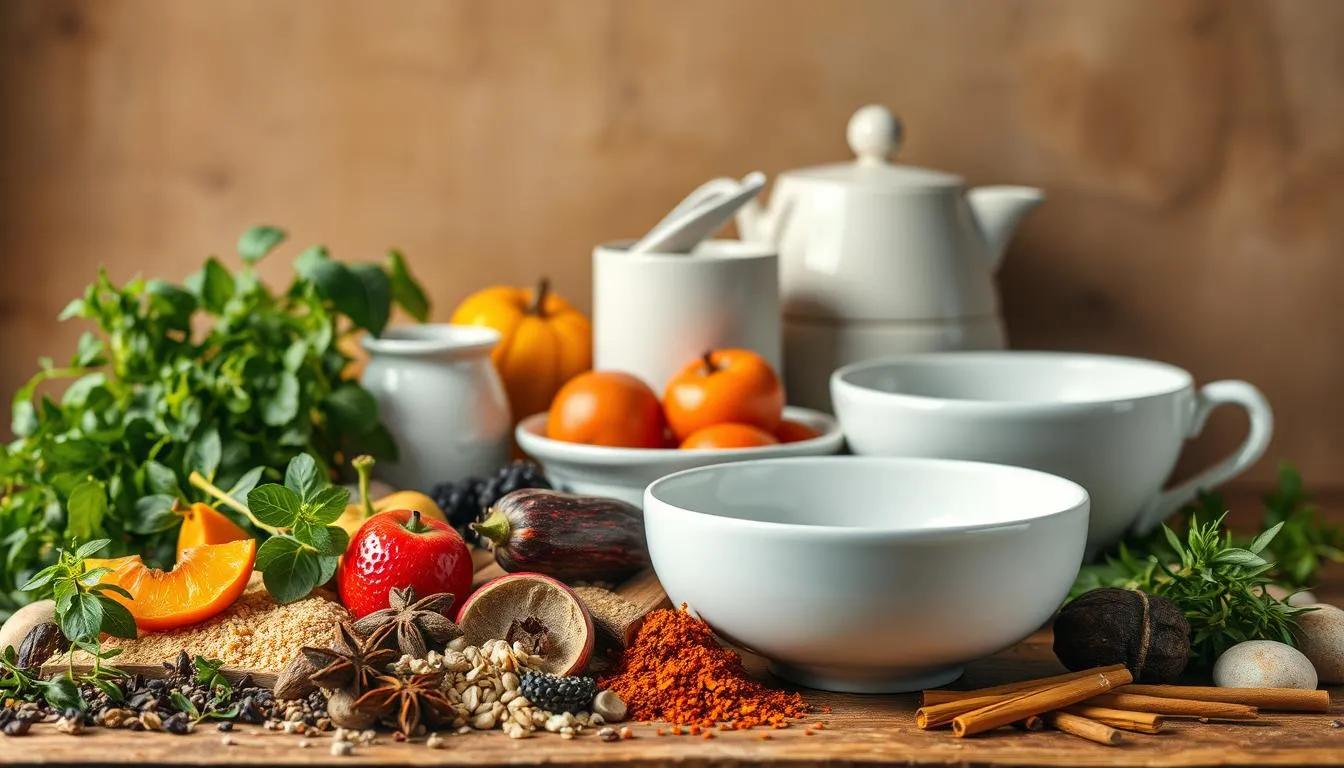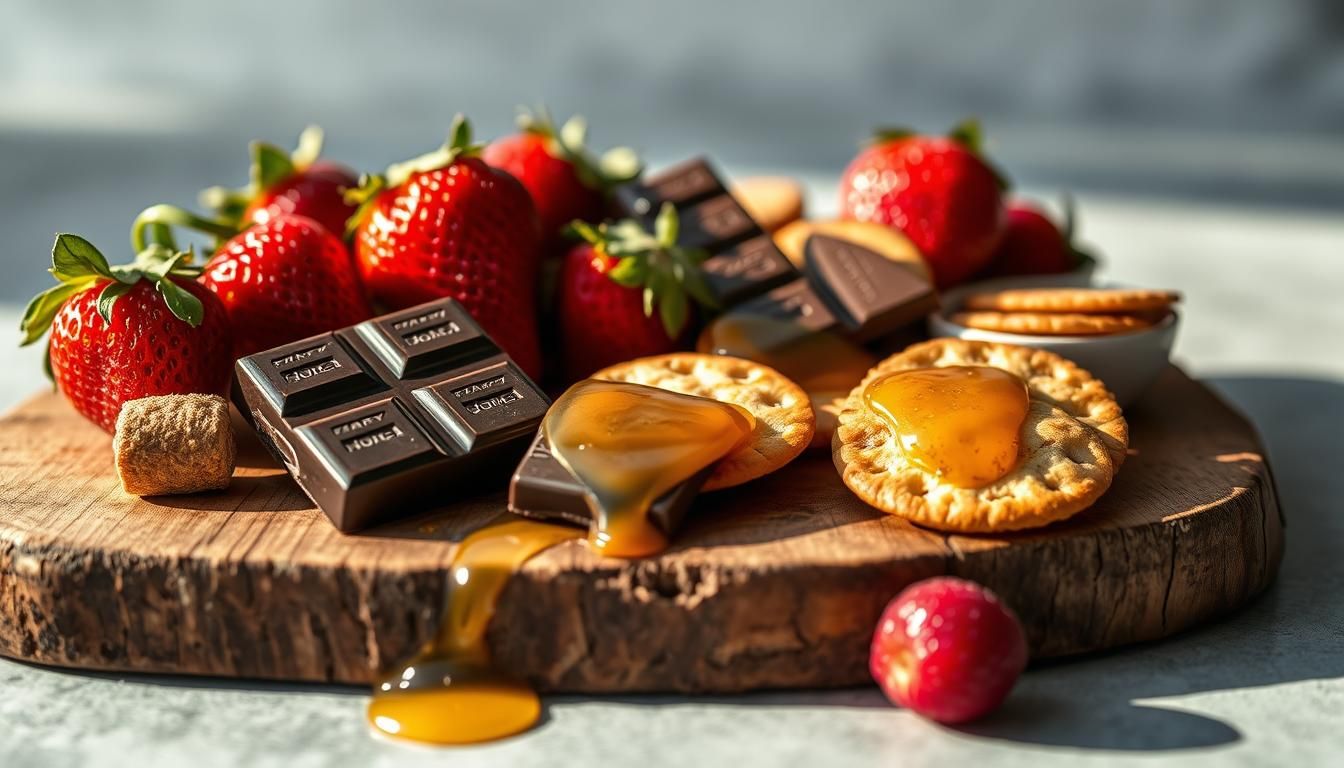I still remember the first time I draped a piece of aged cheese over a simple potato chip and paused. The mix of comfort and surprise felt like a small kitchen triumph.
High‑low flavor pairings are about that exact moment: blending luxury ingredients with familiar foods to create joyful taste experiences. This approach taps into both curiosity and comfort, making everyday cooking more playful and rewarding.
Rooted in science, the method looks for shared flavor notes and smart contrast. It doesn’t need restaurant tricks or special tools, just a willingness to mix nostalgic favorites with seasonal or bold additions.
Across current trends, consumers still reach for classic chocolate, vanilla, and strawberry, while also chasing little twists. In this guide, you’ll get a simple framework, ready combinations, and gentle prompts to turn certain foods into memorable meals.
Key Takeaways
- Blend premium elements with everyday foods to boost taste without fuss.
- Look for shared notes and balanced contrast to make combinations sing.
- This method mixes nostalgia and novelty for relaxed, at-home cooking.
- Science and creativity guide smart matches like chocolate, citrus, and spice.
- Use the playbook flexibly: taste, tweak, and enjoy the process.
What “high-low” really means in flavor—and why it’s trending now
Imagine putting a refined ingredient next to a childhood favorite to make both sing in a new way.
High‑low pairs a premium element or wine with an everyday snack so you get bold taste without losing comfort. This method focuses on shared notes and contrast, not price. It spotlights the humble item while adding a surprising counterpoint.
Right now, consumers crave comfort plus novelty. Familiar items like chocolate, strawberry, and vanilla stay popular, while seasonal notes—maple, peppermint, watermelon—get upscale twists. That blend fuels trends across food and beverage products.
Social media, chefs, and sommeliers promote playful combinations that feel modern and easy to try. Trust what you know: if you love flavors like chocolate or citrus, start there and add a creative counterpoint.

| Component | Role | Example | Why it works |
|---|---|---|---|
| Comfort food | Anchor | Potato chip | Familiar texture and taste |
| Premium touch | Elevator | Crumbled cheese | Adds aroma and richness |
| Beverage | Balancer | Crisp sparkling wine | Clears fat, lifts notes |
“The best pairing honors the dish and makes both parts clearer on the palate.”
- Start small: salty crunch + crisp bubbles.
- Respect the dish’s identity and aim for balance.
The science behind High‑low flavor pairings and today’s taste trends
Researchers map shared scent molecules to predict which ingredients will feel natural together.
Flavor-pairing theory: shared compounds and why some foods click
When two items share key flavor compounds, they often seem harmonious on the palate. Studies and aroma maps show overlapping volatile molecules can make tastes blend more easily.
That doesn’t mean shared compounds always win. Balance, texture, and context still decide success.

Flavor maps: spotting overlaps to spark new combinations
Tools like the Scientific American map visualize overlaps so cooks spot matches such as chocolate-orange or mango-jalapeño. These maps inspire combinations like pineapple-jalapeño or ginger-lemon.
Consumer signals and contrast: what shoppers want now
Data show flavor leads purchase decisions across products and food beverage categories. Consumers want comfort, seasonal riffs, and bold profiles. Use those trends to choose which experiments to try first.
- Try a small bite, note aroma, sweetness, acidity, fat, heat, and texture.
- Remember sweet-salty and savory-sweet contrasts often amplify perceived sweetness or tame bitterness.
“Shared compounds increase the odds, but your palate is the final judge.”
How to master high-low pairings at home: a step-by-step framework
A reliable starting point is a comfort item you already love; it guides every choice after.
Start with a comfort anchor. Choose chocolate, vanilla, strawberry, or peanut butter so the base is familiar and forgiving. This helps you judge how new ingredients change the taste.

Pick a complementary twist
Scan for shared notes like citrus oils, nuttiness, smoke, or floral tones. Match one unexpected ingredient that echoes those notes.
Balance taste profiles
Map sweetness, salt, acidity, heat, fat, and texture. Aim for contrast that supports the dish without masking it.
Test, tweak, and log results
Make mini portions and sip simple beverages—sparkling water, crisp white, or light red—to clear the palate. Note what worked and what to change.
Plate, pour, and serve
Serve playful bites with neat stacking or cones. Choose drinks to amplify strengths: bubbles for salt and fat; acid for fried food; off-dry wines for heat.
| Step | Action | Why it helps |
|---|---|---|
| Anchor | Pick a familiar ingredient | Gives a clear reference point for taste |
| Twist | Add one complementary ingredient | Introduces novelty while sharing key notes |
| Balance | Adjust profiles and texture | Keeps the dish bright and enjoyable |
“Start small and let your palate be the final judge.”
Your high-low pairing playbook: proven flavor combinations to try
Think of this as a short playbook: simple snacks, a smart bottle, and a quick test bite. Start with one familiar food, add a single unexpected element, then sip to reset the palate.
Snack classics with sparkling wines
Ruffles + sour cream & onion dip with Champagne or British bubbles (Gusbourne Brut Reserve) cuts fat and spotlights a sweet salty contrast.
Street-to-suite & budget luxe
Hot dogs meet high-acid Riesling to lift relish and onion notes. Bugles or Pringles topped with crème fraîche and caviar work with an oaked Chardonnay for playful cheese-like depth.
Takeout, spice, and dessert
Orange chicken loves a skin-contact white for texture and minerality. Calm Flamin’ Hot Cheetos with Sauternes or Auslese Riesling—sweetness soothes spice and clears taste buds. Finish chocolate chip cookies with a plush red blend for a silky end.
| Snack | Upgrade | Recommended bottle |
|---|---|---|
| Ridges + dip | Sour cream & onion | Gusbourne Brut Reserve |
| Hot dog | Relish/onion | High-acid Riesling |
| Bugles/Pringles | Crème fraîche & caviar | Oaked Chardonnay |
“Small bites, smart bottles, and quick tasting let you find winning combinations fast.”
High‑low flavor pairings in the wild: brand mashups and cultural momentum
Brands are testing bold mashups that fold upscale ingredients into everyday snacks and meals.
In the marketplace, artisan meets mass favorites and the results often feel daring and familiar at once. Truff put its truffle sauces into Taco Bell nacho fries and a Popeyes spicy mayo sandwich, showing how a luxe accent can lift a quick-service dish and attract curious consumers.
Notable collaborations
- Pringles x The Caviar Company launched a $140 kit with Original, Sour Cream & Onion, and BBQ crisps plus White Sturgeon Caviar and Smoked Trout Roe. The viral product proved a simple combination can spark big attention.
- Van Leeuwen released savory ice creams—Hidden Valley Ranch, Kraft Mac & Cheese, and fries-inspired pints—showing unexpected tastes can find eager buyers.
- Heinz teamed with Fauchon for limited “Tomacrons,” while Swizzles and Bird & Blend made candy-flavored teas. These limited editions create cultural buzz fast.
“A clever pairing honors the base product while adding a single, clear accent.”
| Brand mashup | What | Why it worked |
|---|---|---|
| Truff + Taco Bell / Popeyes | Truffle sauces on nacho fries and spicy mayo sandwich | Luxury note makes a comfort dish feel new to consumers |
| Pringles + The Caviar Company | $140 crisps + caviar kit | Playful contrast: snack format meets luxe ingredient |
| Van Leeuwen collaborations | Ranch, mac & cheese, fries-inspired ice creams | Novel tastes in a familiar product form attract trial |
| Heinz + Fauchon / Swizzles + Bird & Blend | Tomacrons and candy tea blends | Limited runs create urgency and shareable moments |
Behind the headlines is sensible pairing logic: salt, cream, umami, and a touch of sweetness balance well in formats people already love. Try borrowing one idea at home—add a truffle drop to fries or a spoon of roe to a crisp bite—and track which combinations get the best reactions. Those responses will guide your next experiments without breaking the bank.
Build your own combos: a simple matrix for flavors, textures, and price points
Start with a tiny grid that maps what you already love and what might lift it. List anchors down the left: peanut butter, chocolate, cheese, citrus, spice. Put possible counterparts across the top: nuts, dried fruit, cured meat, honey, crisp crackers.
Use shared compounds as a shortlist. Citrus and cocoa share aroma oils; nuts echo chocolate. Pick those matches first, then add contrast—sweet salty, savory sweet, or acid vs. fat—to brighten the bite.
Quick testing rules
- Make one small combination at a time so you can hear what changes in taste.
- Balance textures: pair crisp with creamy, hot with cool, or chewy with crunchy.
- Note sweetness, acidity, heat, fat, and texture as you taste; record what helps the combination work together.
| Anchor | Try with | Contrast to add |
|---|---|---|
| Peanut butter | Dark chocolate, apple slices | Sea salt or citrus zest |
| Cheese | Honey, crisp crackers | Acidic pickles or fruit |
| Chocolate | Orange, toasted nuts | Light salt or a sparkly drink |
“Let science guide the shortlist, and your taste buds be the final judge.”
Keep cooking simple: boards, toasts, skewers, or cones let these combinations shine. Offer mild options for sensitive guests and bolder versions for heat lovers. Use one product upgrade—better chocolate or artisan jam—to see what truly moves the needle for consumers and your table.
Conclusion
Wrap up your experiments by leaning on familiar comforts and one unexpected accent. This keeps testing simple and joyful while you learn what works.
Start with anchors like chocolate or peanut butter, seek shared notes, and balance sweetness, salt, acidity, fat, and texture. Small steps help consumers and cooks spot winning combinations fast.
Try a short list: chocolate-orange for dessert, peanut butter‑strawberry with bubbly water and lime, or chips and dip with sparkling wine. A single upgraded product can turn a casual snack into a standout experience.
Share your hits, keep quick notes, and repeat what others ask for. With this friendly framework and a bit of curiosity, your next pairing will deliver big chocolate smiles and a memorable experience.
FAQ
What does “high-low” mean in culinary combinations?
It’s the idea of pairing everyday comfort ingredients with upscale or unexpected counterparts to create a memorable taste experience. Think peanut butter with a plush red wine or potato crisps topped with crème fraîche and caviar. The contrast between familiar and elevated elements creates surprise and balance.
Why are chefs and brands using this approach now?
Consumers want comfort plus novelty. Food and beverage makers like Van Leeuwen and Pringles collaborate with luxury or nostalgic partners to tap into seasonal trends, social media buzz, and shoppers’ appetite for adventurous profiles. The result: approachable innovation that sells.
What science explains why some combinations work together?
Many successful matches share key aroma compounds or complementary taste notes—sweet vs. salty, fat vs. acid, or spicy vs. cooling. Flavor-pairing theory and flavor maps help identify overlapping components so you can combine ingredients like chocolate and orange or peanut butter and strawberry with predictable success.
How can I build high-low pairings at home?
Start with a comfort anchor—peanut butter, chocolate, or vanilla. Add a twist that shares a flavor note or offers contrast, balance sweetness with acid or salt, test small batches, and pick a beverage to lift the dish. Use texture contrasts—crisp with creamy—to amplify the experience.
Can you give quick, proven combinations to try?
Yes—try chips with sparkling wine, hot dogs with a high-acid Riesling, or orange chicken with a skin-contact white. For snacks, pair Flamin’ Hot Cheetos with Sauternes or Auslese Riesling; for dessert, serve chocolate chip cookies with a plush red blend. Fruit and nut comforts like peanut butter–grape or peanut butter–strawberry are also classic hits.
How do I match beverages to these dishes?
Match by contrast or harmony. Use acid to cut fat (Riesling with rich takeout), bubbles to refresh salt and crunch (Champagne with chips), or sweetness to soothe heat (Sauternes with spicy snacks). Consider texture and tannin: rich, oaked wines suit buttery or umami-rich plates; lighter whites brighten citrus and spice.
Are there affordable ways to recreate luxe pairings?
Absolutely. Use budget-friendly crisps or crackers with a small spoon of crème fraîche and a modest amount of caviar or roe for a caviar-night vibe. Upgrade takeout with a complementary condiment or citrus zest and pair with an accessible wine that shares fruit or minerality notes.
What role do texture and price play in the matrix?
Texture—crisp vs. creamy or chewy vs. smooth—creates contrast that makes flavors pop. Price influences expectation: mixing a low-cost snack with a premium ingredient can heighten perceived value and create social-media-worthy moments without breaking the bank.
How can I experiment without wasting ingredients?
Test small—use tiny portions and note which combinations work. Keep a flavor map or quick notes on shared compounds (citrus, caramel, nutty, roasting notes) and adjust salt, acid, or heat. Small-batch trials help you refine balance before committing to a full recipe or product idea.
Which pantry staples are most useful for creative combos?
Keep peanut butter, chocolate, citrus, salt, spices, cream or crème fraîche, and crunchy snacks on hand. These ingredients mix well with cheeses, fruit, and condiments to form both sweet-salty and savory-sweet matches that appeal to broad tastes.
